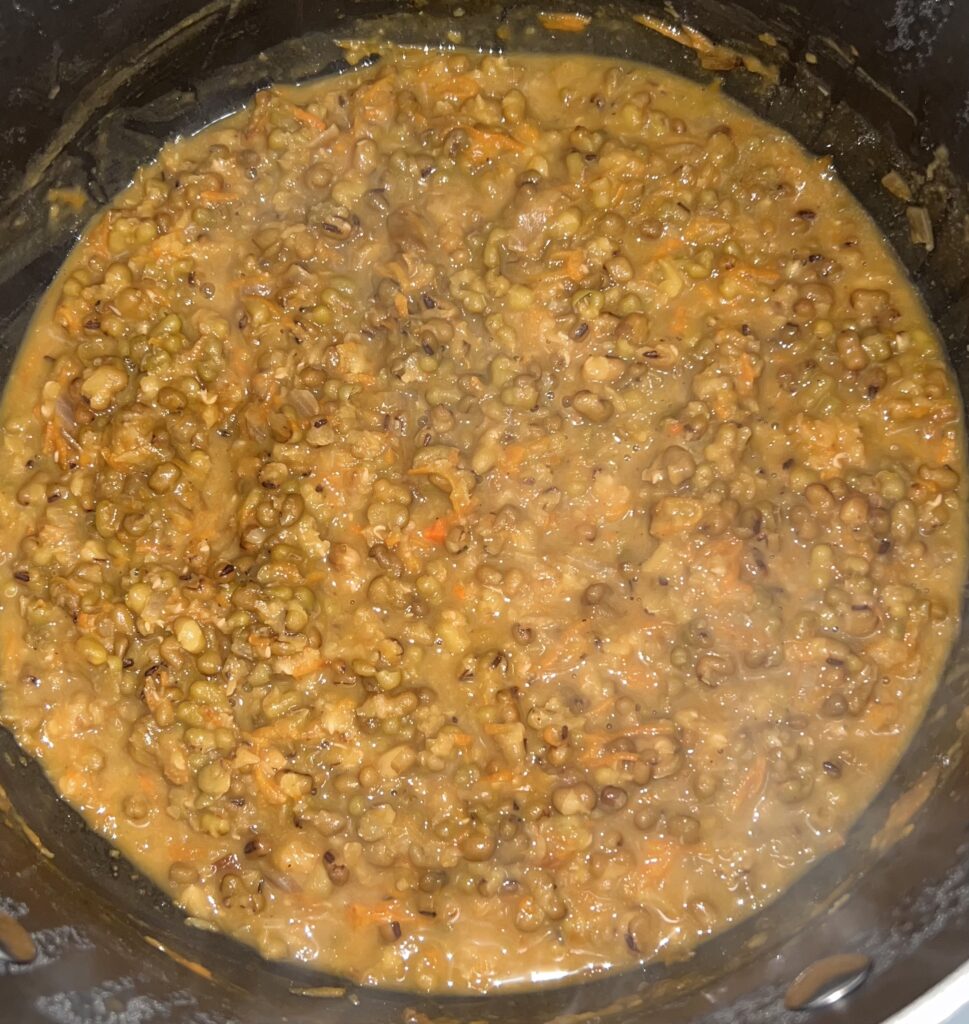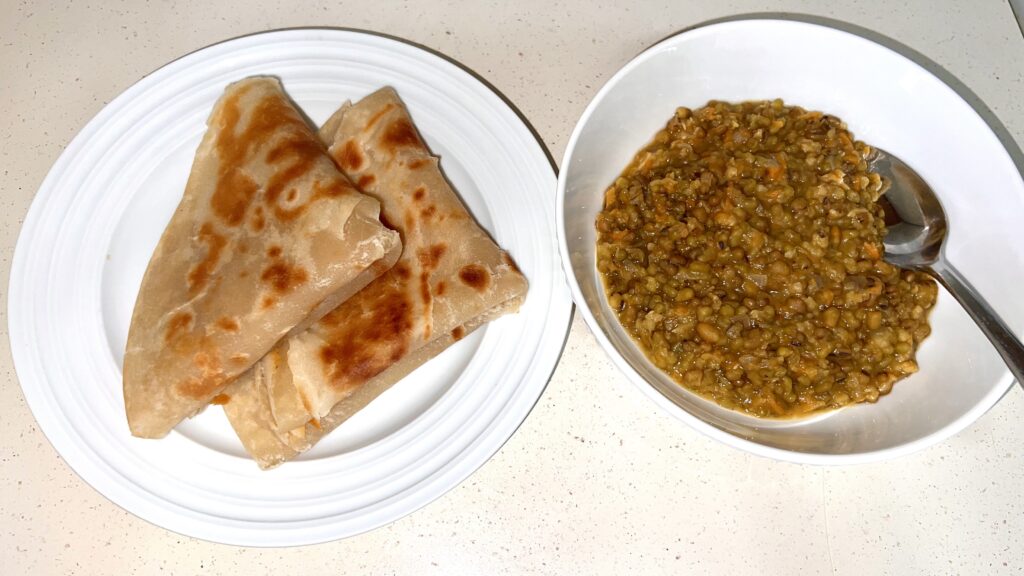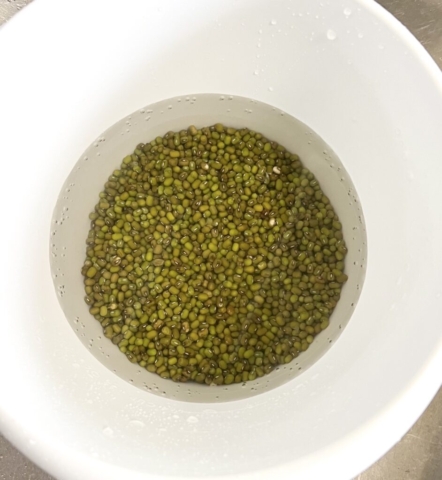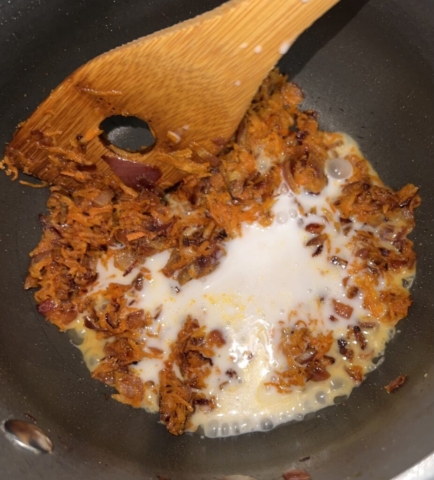This post may contain affiliate links, which means I may receive a commission from purchases made through the links.
Green grams, also known as moong beans, mung beans, or ndengu in Swahili, are popular in many regions of the world owing to their multiple health benefits. Besides, they are readily available, affordable, and easy to cook. But most importantly, green grams stew is simply delicious!

Where are green grams originally from?
Green grams are native to India but I kind of grew up thinking that it was one of our traditional foods because it is a staple in my country and especially in my household. My family has grown green grams since I was a little girl! In Kenya, we call them ‘ndengu’ and they are most popularly used as samosa stuffing. That’s a recipe for another day. Today, I’d like to share with you my easy yet super delicious recipe for green grams stew.
Why should you care about green grams, anyway? What is so good about these little green beans that everybody is fussing about? Well, they have a ton of health benefits. And when I say a ton, I really do mean it.

Health benefits of green grams
- Green grams are the meat alternative for vegetarians. These little beans are packed with proteins.
- Low in calories and fat which makes them an excellent option for weight loss diet and generally healthier diets.
- High fiber content which may also aid in weight loss as a green gram meal will keep you full for longer periods. In addition, the high fiber content aids in digestion, minimizing chances of constipation and ensuring a regular occurrence of bowel movements.
- Green grams contain minerals such as potassium, calcium, magnesium, and phosphorus. Potassium aids in blood pressure regulation and minimizes the chances of heart disease. Calcium, magnesium, and phosphorus aid in the formation of maintenance of strong bones.
- They contain vitamins B, C, and E. Vitamin B (folate) is essential in the formation of healthy red blood cells while vitamins C and E are immunity boosters. Find more detailed explanations of these health benefits in this article.

Aren’t the reasons above enough to make you want to devour a bowl of these yummy little beans right now? I make green grams stew more often than I care to admit and I like to serve it with chapati. The meal is as comforting as it is filling. You have to try it for yourself. By the way, chapati is another dish which I grew up thinking was originally Kenyan until I learned that it also came to my culture from India. There are a lot of East African dishes which are heavily influenced by Indian cuisine due to historical happenings. I will delve more into that in a separate article).
The key ingredients for green grams stew
Green gram stew is not a complicated dish to make. Just a handful of carefully selected ingredients and you have your flavorful stew to savor with a variety of sides.

Coconut milk
Coconut milk does magic to all legumes if you ask me. For this recipe, I used canned coconut milk because it is readily available, handy, and it does the job perfectly. I used the Thai Kitchen unsweetened coconut milk, which is the type that I use in all of my recipes. Fresh coconut milk would add even more ‘coconutty’ flavor. In the coastal region of Kenya (the Swahili coast), ‘pojo’ is an extremely popular dish which is made of green grams and freshly squeezed coconut milk. That dish is closely similar this stew recipe and is also mostly served with chapati.
Carrot
I like to think of carrot as my ‘secret’ addition to the stew as it is something that I decided to try on my own and turned out to be awesome. It is also what differentiates this stew from pojo and my childhood green gram recipes which closely resembled the Indian dal and curries. I mean, am I deviating a little from my family’s recipes? Yes. But it is good to be creative (sometimes), right? But I absolutely adore my childhood recipes.
Carrot adds a great deal of flavor and a beautiful color to the green grams stew. Really, it is the other magic ingredient for legumes! Carrot must be added in the right way though, or else it will not incorporate neatly into the stew and will instead hang around on its own.
Red onions
Red onions stand out with their aroma, which is what I go for in this recipe. In addition, they taste even better when cooked and, when sautéed, they shrink well enough to not be as visible in the stew. Just how I like it. But this is a matter of personal preference. There is no problem at all with using any other type of onion. Yellow onions would be my second choice, in case you were wondering.
Curry powder
Curry powder elevates the flavor of the green grams stew to new heights. I use very little curry in the stew to keep off spiciness because I intend for this to be a kid-friendly recipe (toddler mom, hello!). Besides, this not being a curry, the dish does not really need a lot of spices. But, as you will see in the recipe, you can add a little more curry if you like.
How to make green grams stew
Since we are using dried green grams in this recipe, the first step is to cook them. Rinse your green grams in cold or warm water before cooking. Green grams can be very dusty and dirty even when they look clean and shiny. So, repeat the rinsing until they are clean. Bring a measured amount of water to a boil in a pot and add the green grams. Then reduce the heat to medium. You can boil them covered or uncovered for the start but towards the end of cooking, when the liquid has reduced significantly, make sure the pot is covered to ensure even cooking.
Secondly, fry the onions until they are slightly brown to release their aroma as well as to cook them down. While I like large chunks of crunchy onions in my sautéed dishes, I don’t like that in stews. That’s why I chop stew onions finely and cook them down so they are hardly noticeable. Their aroma is the goal here.

The third step is to add grated carrot. As mentioned earlier, carrot must be sautéed for several minutes until it cooks down, loses the bright orange color, and slightly darkens. This allows it to blend well with the green grams to give you a stew with a thick consistency.

Next, add curry powder and salt. Sauté the mixture for about 10 – 15 seconds to ‘bloom’ the curry powder (maximize its aroma). Then add coconut milk and stir to combine.
Finally, add the cooked green grams (I usually prepare the seasoning in a separate pot and add it onto the green grams. Makes things much easier!) Stir gently, then cover and simmer for 3 minutes. And just like that, your dish is ready to serve! Enjoy your green grams stew with chapati, white rice, sweet potatoes, fresh bread, and much more! Find these serving suggestions with links to the recipes at the bottom of this post.
Storing leftover green grams stew
Place the green grams stew in an airtight container and store it in the fridge or in the freezer. It will be safe for up to five days in the fridge and for up to three months in the freezer.
Like my yummy lentil stew, this is another dish that you can make in large batches and use over a long period of time. Package it in small amounts of single or double servings if freezing. That will make it easy for you to pull out only what you need at a time. Also, smaller sizes will defrost faster.

Reheating green grams stew
You can reheat gram grams stew in the microwave or on the stovetop. Allow frozen stew to defrost fully before reheating.
In the microwave: place the stew in a bowl and reheat for 1-2 minutes or until hot enough.
On the stovetop: place the stew in a cooking pot or pan and heat on low until fully hot. Stir occasionally as it may stick to the bottom of the pot.
Print the Recipe
Best Green Grams (Mung Beans) Stew
Course: VegetarianCuisine: Kenyan, IndianDifficulty: Easy3
servings5
minutes45
minutes220
kcal50
minutesMeasure your ingredients carefully and add each of them in the right way for the best-tasting stew.
Ingredients
Green grams – 1 cup
Water – 4.5 cups
Carrot – 1 medium
Red onion – 1 small (1/4 cup chopped)
Cooking oil – 2 tbsp
Coconut milk (unsweetened) – ¼ cup (optional)
Curry powder – ½ tbsp
Salt to taste
Directions
- Measure green grams in a cup or a glass. Level off on top and pour in a large bowl.
- Rinse the green grams in cold water. Repeat this step until they are clean.
- Measure water into a cooking pot using the same cup or glass that you used to measure green grams.
- Bring the water to a boil. Then, gently add green grams to the pot. Cover and reduce the heat to medium.
- Cook for 45 -55 minutes. They should be cooked through and soft. If not, cook a little longer until soft. Take off the heat when done and leave the pot covered.
- Chop the onion finely.
- Wash, peel, and grate the carrot using the smaller straight-grating side of the grater.
- Place a clean pan on medium-high heat and add cooking oil. Once the oil is hot, add onions and fry until golden brown.
- Add carrot and sauté it for 2-3 minutes, until they cook down.
- Add salt and curry powder. Sauté for 10 – 15 seconds. Then, add coconut milk and stir to combine.
- Add the cooked green grams in and stir gently. Add more salt if necessary. Cover and simmer for 3 minutes.
- Ready to serve (see serving suggestions below)
Recipe Video

Serving suggestions for green grams stew


















